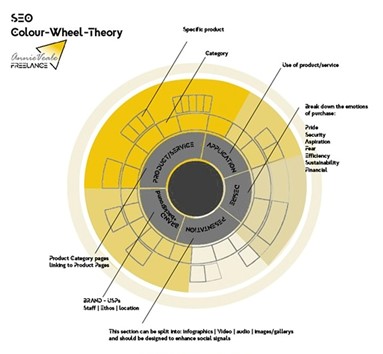
Taking SEO to new heights
By now most B2B PR and Marketing teams recognize the value of Search Engine Optimization (SEO), whether through running an SEO and blogging strategy across their company website or ensuring paid search engine visibility is up to scratch. With 68% of online experiences beginning with a search engine, it’s clear that SEO is a dominating tactic – and if that wasn’t enough to prove its worth, SEO drives an estimate 1,000% more traffic than organic social media!
An understanding of SEO is essential to any B2B PR and Marketing professional’s skillset – so it’s no surprise that as Google regularly changes its algorithms, Marketers are left rushing to adapt their strategies and tactics to keep up!
In the midst of these regular updates, the SEO Color Wheel Theory has emerged to help navigate a coherent strategy.
The SEO Color Wheel Theory is a new addition to the world of SEO, so we’ve taken this week’s blog as an opportunity to take a deep dive into this model: how it works, who it works for, and if it works better than already tried and tested SEO strategies.
SEO and content– a one-stop shop
Before we get into the nitty gritty of the SEO Color Wheel Theory, a quick refresh is needed on the basics of SEO content.
In short, SEO content is online content, typically optimized around a specific keyword, designed to rank highly in search engines such as Google. Hubspot reports that organizations that regularly publish content such as blogs and articles get 350% more traffic than those that don’t regularly publish content. One thing is clear – content is king!
Content is one of Google’s top 3 ranking factors, so B2B PR and Marketing pros take note: SEO without content marketing is like a body without a soul. For any SEO strategy to succeed, it must rely on SEO and content working hand-in-hand.
So where does the color wheel theory come into this?
What exactly is the Color Wheel Theory?
The Color Wheel Theory helps to build a framework hinged on five to six groups for your website, designed to tap into the psychology of the user doing the search.
This SEO color wheel framework has three areas of prime use: as a visualization tool for content SEO projects, a planning tool for SEO projects, and a framework which keeps your site logical, and rules out any thin topic areas.
For sites that lack quality content and organic traffic, this framework lends a helping hand to propel SEO strategies to success!
For instance, you can create categories of content and further micro-topics to increase your site’s or social media account’s linking and sharing opportunities.

The center of this wheel indicates indexed pages that will lead to new visitor traffic. On the outer layers of this wheel, sit indexed core site pages and landing pages. Each section, from the outside to inside serves to increase the success of the content within each content topic group. A well-known methodology coined by HubSpot, the Topic Cluster, has a similar structure.
Putting the theory into practise
The SEO Color Wheel enables PR and Marketing pros with a substantial amount of SEO knowledge to spot strengths and weaknesses in their content usage and thereby optimize their use of content for a successful SEO strategy.
This theory works best by identifying five or six categories to form the innermost circle of content and psychology, comprising brand and background, product and service pages, application of product or service, purchasing motives, and media.
By following these three steps, you should gain a clear indication of the categories that you lack content for, or have excess content for.
- Listing core pages and landing pages – the pages that you are most interested in traffic landing on, which are the most important to your organization’s activity, solutions, or products.
- Working around the wheel, placing those pages in a box on the exterior layer of the wheel. Each category should have three or more pages per section.
- Make a note of best-performing micro-topics – those that attract the most organic traffic. These belong to each corresponding topic section on the interior layer of the wheel.
The pages that you have listed but haven’t been added to either the interior or exterior layer of sections in the wheel should be identified as key pages to be improved on to attract more traffic. These pages should lie in the middle segment, adjoining and linking inner to outer pages.
By following these steps and applying them to the color wheel, you can successfully identify content areas that are lacking in organic visitor traffic, and require improved SEO.
But here’s the spoke in the colour wheel – outbound SEO opportunities
Yes, in theory and in practice, the SEO Color Wheel Theory works to improve the SEO function on company-owned media channels, but it misses key outbound SEO opportunities in earned media.
When PR pros get their client’s thought leadership content, full of quality links, placed in top-tier media outlets, it can help ensure that client appears at the top of Google searches, and help increase traffic to their website – leading to greater search engine exposure!
Inbound or outbound – it’s about the SEO and content one stop shop
Ensuring your earned media content is dominating that first results page is essential in the SEO textbook – and it starts with content generation. Finding relevant keywords and integrating them into your content is a core function of SEO. Keywords are a staple tactic to increase search traffic and SERP rankings, but remember – avoid cramming as many in as possible, take time to research the top-performing keywords in your client’s industry.
Google agrees
Don’t forget, dominating search results is a big win – but not if you can’t ensure click through to your own website. All placed copy should include quality backlinks to relevant pages on your client’s company website to divert organic traffic back to your client’s owned assets – and that’s not all. With earned media placements, Google considers backlinks on these authoritative domains when ranking your own site in its organic search results. A consistent PR campaign with even a modest budget can generate 3+ bylined placements per month in a particular industry or geography.
The digital SEO battle versus the old SEO – the brain
Content is key, especially in the race to reach that first page of Google search, but to maximize client messaging, PR and Marketing pros mustn’t forget the human touch!
With all of the latest and greatest advancements in the world of SEO, it can be easy to forget what really drives sales – people! So yes, these new and shiny models and frameworks may be the future of SEO strategy, but maintaining the human touch will always be just as important.
The 360 degree SEO strategy
Incorporating these emerging owned-site strategies with traditional tactics of utilizing keywords and backlinks, alongside harnessing the power of memory recall, creates the ultimate SEO trifecta!
So here’s the recipe for success – generating good quality, SEO-optimized content and placing it in top-tier industry publications while following the SEO Color Wheel framework to ramp up SEO activity on your own sites.
A truly 360-degree SEO strategy (no wheel pun intended!).
Caitlin Goldsmith is PR Executive at IBA International

Leave a comment